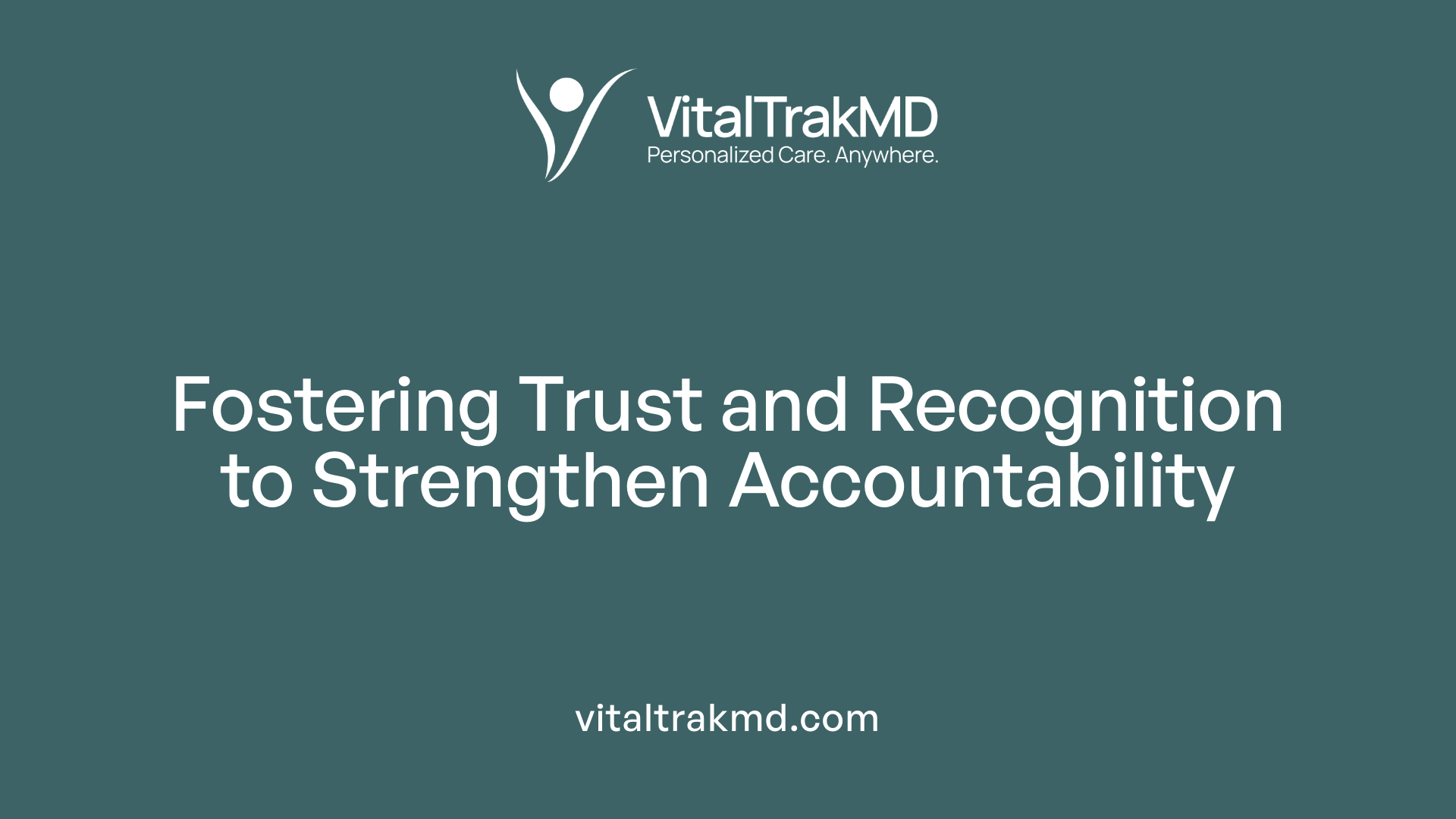How Hybrid Care Encourages Accountability Through Regular Check-Ins

Understanding the Power of Regular Engagement
Hybrid care models are transforming the way healthcare providers and patients collaborate, emphasizing continuous interaction, shared responsibilities, and transparency. Central to this evolution are regular check-ins, which foster accountability by ensuring that care is aligned, progress is monitored, and commitments are upheld. This article explores how structured, consistent communication reinforces responsibility across hybrid teams, ultimately enhancing healthcare outcomes and patient satisfaction.
Establishing Clarity Through Shared Objectives in Hybrid Care

What is the impact of regular check-ins on employee engagement and performance management?
Regular check-ins play a vital role in fostering a productive and motivated hybrid team. These meetings serve as consistent touchpoints where managers and employees can discuss progress, clarify expectations, and address challenges proactively.
By maintaining frequent communication, organizations create a culture of transparency and trust. Employees feel valued when their achievements are recognized and their concerns listened to, which increases engagement.
Moreover, ongoing feedback during these check-ins helps align individual goals with broader organizational objectives. This alignment enhances performance management by ensuring everyone is moving in the same direction and adjusting their efforts as needed.
Regular check-ins also support professional growth, as they provide opportunities for mentorship and skill development. When managers inquire about career aspirations, it reinforces commitment and motivates staff.
Overall, implementing regular interactions not only improves immediate performance but also strengthens long-term engagement, reduces turnover, and cultivates a resilient organizational environment.
How do rich conversations, including discussing, agreeing, and documenting goals, enhance team clarity?
In hybrid care settings, rich team conversations are essential for establishing a shared understanding of objectives. These dialogues involve open discussions where team members collaboratively explore goals, reach consensus, and formally record agreements.
This process ensures clarity on team directions, priorities, and individual responsibilities. Documenting shared objectives creates a reference point, reducing misunderstandings and aligning efforts.
Leadership practices such as setting agendas and asking powerful questions during meetings encourage active participation and deeper thinking. These techniques help uncover underlying assumptions, clarify ambiguities, and foster collective ownership.
When teams discuss and agree on goals openly, they build a sense of accountability and trust. Clear, documented objectives also facilitate progress tracking and accountability.
Together, rich conversations and formal documentation create a transparent, engaged, and aligned team environment crucial for success in hybrid work models.
Fostering Commitment and Confidence via Stakeholder Engagement
How do hybrid care models promote accountability?
Hybrid care models enhance accountability by creating a framework where patients and healthcare providers maintain open, ongoing communication. Using tools such as remote patient monitoring devices and electronic messaging platforms, providers can regularly check on patient progress and receive real-time updates.
Structured check-ins, supported by evidence-based guidelines and performance metrics, help set clear expectations for treatment outcomes. These tools not only facilitate proactive interventions but also foster a sense of shared responsibility.
Financial incentives aligned with quality care, such as hybrid payment systems, further promote a focus on patient-centered outcomes. This integrated approach encourages healthcare teams to deliver high-quality, efficient care, leading to improved coordination and a culture of accountability.
Chartering conversations to agree on responsibilities, priorities, and resources
In hybrid healthcare settings, establishing clarity begins with comprehensive chartering discussions among all stakeholders. These conversations aim to define priorities, responsibilities, and resources explicitly. Patients and providers collaboratively identify treatment goals, responsibilities for medication adherence, lifestyle modifications, and necessary support services.
Agreeing on access to tools, technology, and organizational support enables everyone to work with confidence. Documenting these shared objectives fosters commitment and ensures accountability by providing a reference point for ongoing evaluation.
Building confidence through shared responsibilities and organizational support
Confidence in hybrid teams is strengthened when responsibilities are distributed clearly and organizations provide robust support. When providers have access to training, technology, and organizational resources, they can deliver consistent, patient-tailored care.
Moreover, involving patients in shared decision-making and goal-setting enhances their confidence and engagement in their care plans. By emphasizing transparency and empowering stakeholders through open dialogue, hybrid care models build trust and ensure sustained commitment.
| Aspect | Approach | Benefits |
|---|---|---|
| Responsibility Clarity | Collaborative chartering conversations | Increased commitment and accountability |
| Organizational Support | Providing training, resources, and leadership backing | Greater confidence and consistency in care |
| Communication Tools | Telehealth platforms, messaging, and data sharing | Enhanced transparency and engagement |
Effectively implementing these strategies ensures that hybrid care models thrive on mutual trust, clear roles, and strong organizational backing, ultimately leading to improved health outcomes.
Leadership Strategies to Integrate Regular Check-Ins
How should leadership maintain accountability through regular engagement?
Maintaining accountability in hybrid teams hinges on consistent, meaningful interactions led by proactive leadership. Leaders should start by clearly establishing shared goals and expectations, often through frameworks like DAC (Discuss, Agree, Communicate). This foundational step ensures everyone understands their roles and responsibilities, fostering alignment.
Regular check-ins, such as weekly team meetings and one-on-one conversations, create opportunities for leaders to review progress, address challenges, and provide feedback. These interactions help build trust and ensure team members stay engaged and committed. Using accountability tools like scorecards, project management software, and shared team charters keeps everyone aligned and aware of priorities.
An empathetic management approach is vital—leaders should promote transparency, provide support, and be flexible to individual needs. Showing genuine care and understanding helps cultivate ownership and motivation.
Effective hybrid leadership also involves nurturing an inclusive environment where communication channels are open and accessible. Employing technology like Zoom, Teams, and collaborative platforms enables seamless, ongoing engagement regardless of location.
Ultimately, consistent communication, shared goals, proper tools, and a human-centered leadership style work together to foster accountability and maintain high performance in hybrid teams.
Implementing Consistent Communication Protocols
 To ensure effective management of hybrid teams, organizations must establish clear and consistent communication protocols. This involves the strategic use of collaboration tools and structured check-ins that keep team members connected and aligned.
To ensure effective management of hybrid teams, organizations must establish clear and consistent communication protocols. This involves the strategic use of collaboration tools and structured check-ins that keep team members connected and aligned.
Utilizing platforms such as Microsoft Teams, Slack, or Google Meet enables seamless real-time communication, whether team members are working remotely or in the office. Regularly scheduled check-ins—be they daily stand-ups, weekly team meetings, or one-on-one sessions—serve as vital touchpoints to share updates, identify challenges, and reaffirm goals.
Setting explicit expectations around responsiveness and accountability also plays a crucial role. Leaders should communicate clear guidelines about response times, availability windows, and preferred communication channels. These standards help prevent misunderstandings and promote a culture where everyone understands their responsibilities.
Use of Collaboration Tools and Structured Check-ins:
- Tools like Trello, Asana, or Monday.com assist in tracking project progress and assigning responsibilities.
- Video conferencing fosters face-to-face interaction, enhancing trust and engagement.
- Asynchronous updates through shared documents or chat channels ensure inclusivity for teammates across different time zones.
Setting Explicit Expectations for Responsiveness and Accountability:
- Define core hours during which team members are expected to be available.
- Use status indicators (e.g., 'In a Meeting,' 'Out of Office') to communicate availability.
- Regularly review progress against measurable goals to keep accountability transparent.
How can organizations implement effective check-in practices in hybrid work environments?
Organizations can establish consistent routines such as daily or weekly briefings that focus on sharing updates, addressing obstacles, and realignment. Utilizing a mix of synchronous and asynchronous communication tools like Slack, Teams, or video calls ensures inclusivity and maintains open channels, while brief, structured interactions—typically around a few minutes—help foster genuine connections and team cohesion.
Leaders should emphasize active listening, transparency, and customized check-ins that address individual needs and well-being. Encouraging honest feedback through surveys and informal conversations allows ongoing improvement of communication practices, fostering trust and stronger team relationships.
Ultimately, strategic planning of communication—coupled with clear expectations, effective tools, and regular feedback—creates a resilient and engaged hybrid workforce.
Maintaining Oversight and Performance Through Technology

How can organizations maintain consistent communication and performance oversight in hybrid work?
In hybrid work environments, maintaining communication and ensuring that team performance aligns with organizational goals is essential. Organizations should adopt a combination of clear protocols and effective tools to bridge the distance between team members.
One effective strategy involves establishing transparent communication protocols. These include setting expectations for response times, providing regular updates, and clarifying deliverables. For example, using shared project management platforms like Trello, Asana, or Microsoft Planner helps teams track progress, update statuses, and keep all members informed.
Regular check-ins, such as weekly team meetings or daily stand-ups, are vital for aligning objectives and addressing challenges promptly. Video conferencing tools like Zoom or Microsoft Teams facilitate face-to-face interactions, fostering a sense of connection and accountability.
Creating accessible repositories for project documents and updates, such as shared drives or organizational intranet, ensures transparency and easy access to information. This openness minimizes misunderstandings and ensures that everyone is on the same page.
Fostering a culture of active listening and empathy during virtual interactions also enhances trust. Encouraging open dialogue, providing constructive feedback, and recognizing achievements motivate team members and sustain high performance.
Training employees on effective virtual communication skills—such as clarity in messaging, attentive listening, and respectful interactions—is equally important. Cultivating these skills helps reduce miscommunications and boosts overall productivity.
In summary, consistent communication and performance oversight in hybrid settings rely on clear expectations, the right mix of collaborative tools, regular touchpoints, and a culture that values openness, feedback, and inclusivity. This integrated approach ensures teams stay connected, motivated, and aligned towards common goals.
Hybrid Care Models and Accountability Culture

How do hybrid care models promote accountability?
Hybrid care models enhance accountability by creating a system where continuous, open, and transparent communication is central. They utilize various tools such as remote patient monitoring devices, electronic messaging platforms, and telehealth consultations to keep healthcare providers engaged and informed about patient progress.
Structured check-ins and clear expectations are vital components of these models. Regular follow-ups allow providers to assess patient health data, address concerns promptly, and adjust treatments as needed. Supported by evidence-based guidelines and standardized metrics, hybrid care ensures that quality remains a priority, focusing on patient outcomes rather than just service volume.
Financial incentives aligned with quality care, such as value-based payment systems, further motivate providers to deliver responsible and effective care. Overall, hybrid care models foster a culture where responsibility, collaboration, and accountability are embedded in daily practice, leading to improved health outcomes and sustainable care delivery.
Promoting Inclusivity and Cultural Sensitivity
Respecting diverse backgrounds and needs.
In hybrid teams, respecting the diverse backgrounds and needs of team members is fundamental to fostering an inclusive environment. This involves recognizing different cultural values, communication preferences, and personal circumstances. For example, providing flexible work hours supports those with varying time zones or personal commitments. Leaders should actively listen and show understanding of individual challenges, ensuring every team member feels valued and respected.
Creating a culture where varied perspectives are welcomed encourages open dialogue and innovation. Utilizing inclusive language and culturally aware practices helps prevent misunderstandings and promotes mutual respect. Training sessions on cultural sensitivity can equip teams with the skills needed to navigate differences effectively.
Providing equal participation opportunities in hybrid settings.
Ensuring all team members have equal access to participation opportunities is vital in hybrid work. This includes structuring meetings to enable remote employees to voice their opinions, such as using video conferencing tools that encourage everyone to contribute. Implementing protocols like round-robin sharing or designated discussion times prevents in-office employees from dominating conversations.
Organizations should also provide accessible resources and technology, ensuring remote workers can engage fully. Equal participation fosters a sense of belonging, boosts morale, and strengthens team cohesion. Regularly soliciting feedback on inclusivity practices helps identify areas for improvement.
What communication techniques support accountability in hybrid settings?
Effective communication techniques that support accountability in hybrid settings include establishing clear and consistent messaging about expectations, objectives, and deadlines, while utilizing a variety of tools such as Slack, Teams, Zoom, and project management software to maintain visibility. Regular check-ins, constructive feedback, and transparent sharing of progress through dashboards or shared calendars foster trust and highlight individual contributions. Promoting open, asynchronous communication and designated no-meeting days encourage deep focus and result-oriented performance. Building a culture of accountability is further supported by leading through example, recognizing achievements, and creating a safe environment for honest dialogue. Ultimately, combining transparent communication with trust-based autonomy and measurable goals enhances accountability in hybrid teams.
Trust and Recognition as Pillars of Accountability

What are the benefits of regular check-ins for accountability and team trust?
Regular check-ins play a vital role in strengthening accountability within hybrid teams. They ensure ongoing, clear communication by providing a dedicated space for discussing progress, challenges, and expectations. This consistency helps build trust between team members and leaders, fostering a sense of reliability and transparency.
These meetings also improve understanding and mutual respect, as they encourage open dialogue and active listening. By addressing issues early, they prevent misunderstandings and conflicts from escalating. Moreover, regular check-ins offer opportunities for timely feedback, recognition, and support, which motivate employees and reinforce their sense of responsibility.
In addition, check-ins enable managers to support individual growth, align efforts with organizational goals, and maintain engagement. They cultivate a positive atmosphere where team members feel heard and valued, ultimately leading to a more cohesive and committed hybrid workforce.
How does fostering a positive culture that values responsibility impact hybrid teams?
Building a culture that emphasizes responsibility, transparency, and trust encourages employees to take ownership of their work. Recognizing and celebrating successes publicly boosts morale and demonstrates that responsible actions are valued. Leaders who actively listen, provide positive feedback, and acknowledge effort create an environment where accountability is naturally reinforced.
Such a culture also promotes inclusivity and fairness by ensuring all team members feel appreciated regardless of their work location. It encourages proactive communication, empowers employees to make decisions independently, and reduces the need for micromanagement.
Fostering responsibility within a positive culture enhances team cohesion and motivation. When accountability is rooted in mutual respect and shared values, employees are more likely to engage meaningfully, support one another, and contribute to collective success, even across diverse work arrangements.
Sustaining a Culture of Responsibility in Hybrid Teams
Embedding regular check-ins into the fabric of hybrid work is essential for fostering a responsible, engaged, and high-performing team. These interactions not only reinforce clarity and accountability but also nurture trust, inclusivity, and resilience within the team. Leaders play a vital role in cultivating this culture through transparency, empathy, and consistent engagement. When done effectively, regular check-ins become more than routine—they transform the hybrid environment into a hub of shared responsibility and continuous improvement, ultimately advancing healthcare outcomes and organizational success.
References
- 4 ways to establish team accountability in a hybrid work environment
- 7 Behaviors That Build Trust in Virtual Teams and Hybrid Teams
- Leading Hybrid Teams with Empathy - Madison-Davis
- Leading Hybrid Teams: Creating an Effective Working Model with ...
- The Employer's Guide to Employee Wellbeing in a Hybrid Workplace
- Good Communication Practices in Hybrid Federal Workplace
- Principles for Managing a Hybrid Team | Cardinal at Work
- Setting Clear Performance Expectations in the Era of Hybrid Work
Recent articles
Want to Feel Better and Live Healthier?
Join hundreds of patients taking control of their health with personalized care that fits their life – not the other way around.
Rated 4.8/5 by 32+ customers







